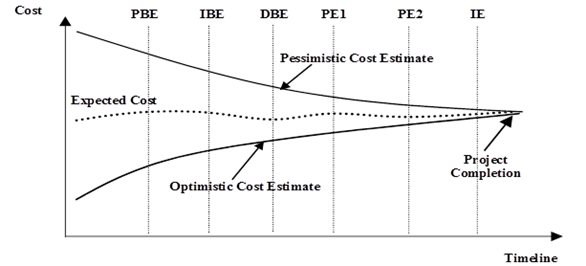 The financial case answers the questions:
The financial case answers the questions:
• Is the investment proposal affordable?
• How will we fund it?
The financial case determines the affordability of the investment proposal. It outlines the whole-of-life costs and funding requirements of the recommended option, taking into account all potential funding sources, risks and uncertainties.
A fit-for-purpose financial case will give decision makers confidence that they are committing to an option and delivery pathway that is affordable and unlikely to create unforeseen impacts on limited funding sources or to force significant trade-off decisions during implementation.
A key principle of the Business Case Approach (BCA) is that business cases are developed progressively, one step at a time. This means there will sometimes be more than one place where work is needed on the financial case, because the business case will need different things from the financial case as it develops and as understanding of the investment grows.
The financial case is developed within one or more business case phases, such as:
It is also part of a pre-implementation phase (if used).
The financial case will be revisited and built up in each phase, as knowledge gaps are filled and cost estimates are refined.
The main work on the financial case begins when the strategic and economic cases have been developed, as there is no recommended option to work on until that point. However, elements of the financial case may need to be understood early. For example, understanding affordability envelopes may create parameters for the economic case (optioneering), different funds available and their priorities may inform the strategic case (strategic context), and financing mechanisms may influence the commercial case (staging or sequencing needs).
Within each phase of development, the key actions you need to focus on for your financial case will depend on a number of things, including:
The table below illustrates how the focus and level of detail needed in the financial case can change as the business case progresses from one phase to the next. For more information on each phase, please select the relevant link from the first column.
| Phase | Focus of the financial case |
|---|---|
|
|
|
|
|
Indicative business case phase and early single-stage business case phase |
|
|
and late single-stage business case phase |
|
The key actions for the financial case are:
In completing these actions, it is important to use sensitivity testing where appropriate to fully understand funding risks or uncertainties associated with each option, including the recommended option. The Monetised benefits and costs manual (chapter 7) contains information on undertaking sensitivity and risk analysis,
Monetised benefits and costs manual
It is also important to assess the funding priority of the proposed investment within the relevant activity class and/or work category. For more information see the Planning and Investment Knowledge Base.
Planning and Investment Knowledge Base
Cost estimation is a core part of the financial case. It is not possible to determine whether a project is affordable without a good understanding of how the whole-of-life costs involved. Failing to get the project’s cost estimation correct may lead to decision making around a project’s affordability being completely wrong.
Whole-of-life costs
To make meaningful comparisons of affordability between alternatives and options, and to understand the financial impacts of the recommended option, it is important to present costs as whole-of-life costs.
Whole-of-life costs include all significant costs that are associated with an activity, including planning and investigation, delivery, maintenance, operation and renewal.
A robust method of cost estimation must be followed. NZ Transport Agency Waka Kotahi (NZTA) projects are required to follow the standard practices and techniques in the Cost estimation manual (SM014).
Cost estimation manual (SM014)
Approved organisations may use their own cost estimation methods; however, these must be robust and incorporate best practice. Good cost estimation also requires practitioners to use critical thinking skills and experience, supported by a good understanding of project risks and uncertainties.
Cost estimation is not an exact science, and it takes into account uncertainties and risks. Costs are progressively refined through the development of the business case by increasing the understanding, information and detail of each component of the project, as shown in the figure below, which comes from SM014.

Refining the cost estimation as you develop the business case
As you develop the business case, you will learn more about the requirements of the project, and develop understanding of the uncertainties and risks involved. This iterative process allows cost estimates to be improved and estimation ranges to be narrowed through each phase of business case development. It also allows uncertainties and risks to be managed and factored into decisions.
When developing cost estimates in the early phases of a business case, there will be gaps in your understanding of project scope and risks to account for. However, it is expected that these gaps will be progressively reduced as you move from the early phases of the business case to later phases (as illustrated in the figure above).
Using ranges in cost estimates are a reflection of knowledge gaps and risks at any given point in the business case process. It is important that cost ranges are continually reassessed and refined these throughout the business case development cycle. Any unmitigated risks or uncertainties should be appropriately priced and the cost estimate should actively respond to the risk and uncertainty registers, with key assumptions being clearly recorded.
Ranges for cost estimates for IBC, DBC and SSBCs are normally expressed as expected (P50) and 95 percentile (P95) estimates. The P50 estimate is the base estimate with a contingency allowance. The contingency is an objective allowance for remaining knowledge gaps and remaining risk. The P95 is an estimate is made up of the base estimate plus contingency plus costed risk, which theoretically should be exceeded by the final cost only once in 20 occasions.
Optimism bias is a cognitive bias that leads people to significantly underestimate the probability of an undesirable outcome, and overestimate the probability of a favourable outcome. In the context of cost estimation, it frequently leads to:
In developing the financial case, appropriate care must be used to minimise or, where possible, avoid optimism bias. Failure to achieve this can result in significant cost over-runs, or failure to deliver the anticipated benefits – both of which are key measures of project success.
The effects of optimism bias on the financial case can be minimised several ways, including:
Above all, it is important to use your critical thinking power skills in the preparation of the financial case.
A key focus throughout the five-case model is to identify and manage risks and uncertainties.
Although they are closely related, risks and uncertainties are typically managed in different ways within the BCA. For a detailed overview of how risks and uncertainties are treated throughout the five-case model, including definitions and templates for risk and uncertainty registers, see our detailed guidance.
Risk and uncertainty in the five-case model
Risks and uncertainties can arise within each of the five cases. As work on the business case progresses, risks and uncertainties must be identified, recorded and tracked. You should also capture the proposed approach to managing each risk or uncertainty, which will ultimately form a key focus for the management case.
It is good practice to set up registers to track risks and uncertainties from an early stage in the business case. The registers continue to be used throughout development of the business case to capture risks and uncertainties from all of the cases.
The financial case should focus on identifying risks and uncertainties that relate to:
You may need to develop an understanding of these risks or uncertainties for each alternative or option to inform the optioneering process, and also to determine any residual risks or uncertainties associated with the recommended option.
The financial case will be developed in parallel with the wider business case and will draw upon the following elements from other cases in the five-case model:
A good financial case will demonstrate a clear linkage to these elements. They are important because they inform the cost estimator about and make transparent project costs imposed by design, functionality, construction methodology and project site. To use these elements effectively the cost estimator must apply their skills and experience, but most importantly critical thinking.
Engagement while developing the financial case relates primarily to funding agreements and funding availability:
More information about engagement in the BCA is available on our website.
Engagement and the Business Case Approach
This will depend on which phase you are working on, how complex the investment is and how much risk or uncertainty is involved.
However, there are a few things that can help you, including:
How to self-assess your business case
When assessing applications to fund business case phases from the National Land Transport Fund (NLTF), NZTA will seek assurance that the financial case has been adequately developed.
As a principles-based approach, there is no checklist of specific actions to follow to ensure that NZTA’s expectations regarding the financial case are being met. However, there are some questions that assessors will consider to ensure the principles relating to the financial case are being followed:
Contact your NZTA investment advisor or email the Business Case Process team at businesscaseprocess@nzta.govt.nz